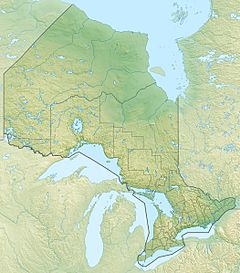Namewaminikan River facts for kids
Quick facts for kids Namewaminikan River |
|
|---|---|
|
Location of the river mouth in Ontario
|
|
| Country | Canada |
| State | Ontario |
| Region | Northwestern Ontario |
| District | Thunder Bay |
| Physical characteristics | |
| Main source | Unnamed lake 450 m (1,480 ft) 49°17′13″N 87°57′36″W / 49.28694°N 87.96000°W |
| River mouth | Lake Nipigon 260 m (850 ft) 49°39′48″N 88°05′39″W / 49.66333°N 88.09417°W |
| Basin features | |
| River system | Great Lakes Basin |
| Tributaries |
|
The Namewaminikan River is a river located in the Thunder Bay District of Ontario, Canada. It is an important part of the Great Lakes Basin, which is a huge area of land where all the water drains into the Great Lakes. This river flows into Lake Nipigon, a large lake in northwestern Ontario.
Contents
Where Does the River Flow?
The Namewaminikan River starts its journey in a small, unnamed lake in northern Ontario. This starting point is about 12 kilometres (7.5 mi) east of where the river eventually meets Lake Nipigon.
River's Journey Through Lakes and Land
As the river flows, it travels northeast through several lakes. These include Georgia Lake, Barbara Lake, Parks Lake, and Trapnarrows Lake. It then reaches Gathering Lake, where it is joined by two other water bodies: the Roslyn River and Margret Creek.
After Gathering Lake, the Namewaminikan River continues north. It enters the area of Greenstone and flows under Ontario Highway 11. This highway is also part of the Trans-Canada Highway, a major road that crosses Canada. The river then reaches Turkey Lake, where it is joined by Wildgoose Creek.
Waterfalls and Other Creeks
The river then turns west, passing through Partridge Lake. Along this part of its journey, the Namewaminikan River flows over several beautiful waterfalls. These include Kinghorn Falls, Chute Falls, and Twin Falls. It also takes in water from other smaller streams, called tributaries, like Foxear Creek and Corrigan Creek. Finally, after passing through the Long Rapids, the river reaches its mouth at Lake Nipigon. From Lake Nipigon, the water continues its journey through the Nipigon River to Lake Superior, one of the Great Lakes.
Using the River's Power
The Namewaminikan River is being used to create clean energy! A special project called Namewaminikan Hydro is working to build power stations along the river.
Clean Energy Project
This project is a partnership between three First Nations communities: the Animbiigoo Zaagi'igan Anishinaabek First Nation, the Biinjitiwabik Zaaging Anishnabek First Nation, and the Bingwi Neyaashi Anishinaabek First Nation. They are building two "run-of-the-river" hydroelectric power stations.
How "Run-of-the-River" Works
"Run-of-the-river" means that the power stations use the natural flow of the river to make electricity. They don't need to build a large dam that creates a big reservoir. This method is often seen as more environmentally friendly. The two stations, located at Long Rapids and Twin Falls, are designed to produce a total of 10 megawatts of power. This amount of power can help provide electricity for many homes and businesses.
What Are Tributaries?
Tributaries are smaller rivers or streams that flow into a larger river or lake. They add water to the main river, making it bigger.
Tributaries of the Namewaminikan River
Here are some of the creeks and rivers that flow into the Namewaminikan River:
- Corrigan Creek (joins from the left side)
- Foxear Creek (joins from the left side)
- Lapierre Creek (joins from the right side)
- Legault Creek (joins from the left side)
- Wildgoose Creek (joins from the right side)
- South Beatty Creek (joins from the right side)
- Margret Creek (joins from the right side)
- Roslyn River (joins from the right side)


